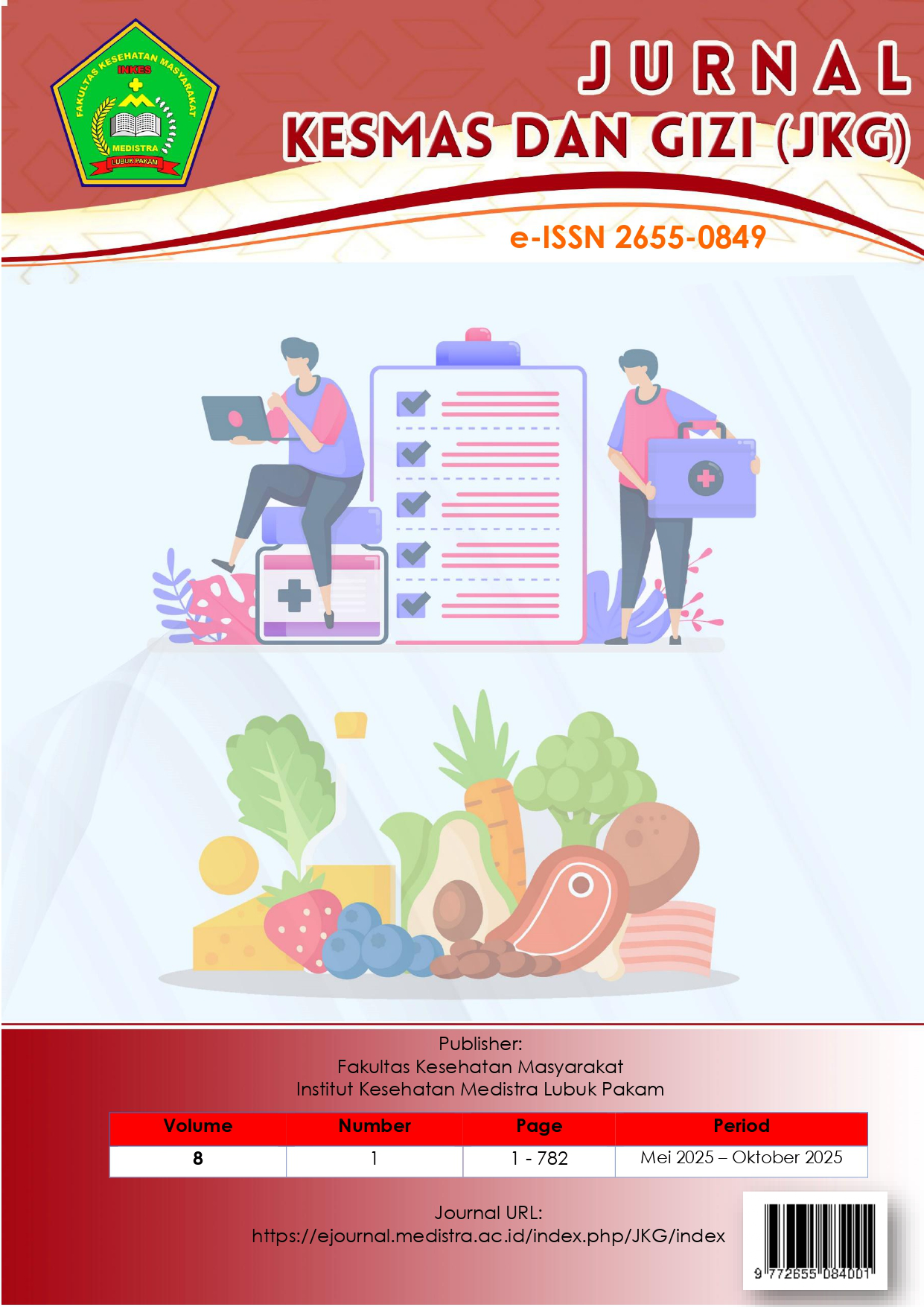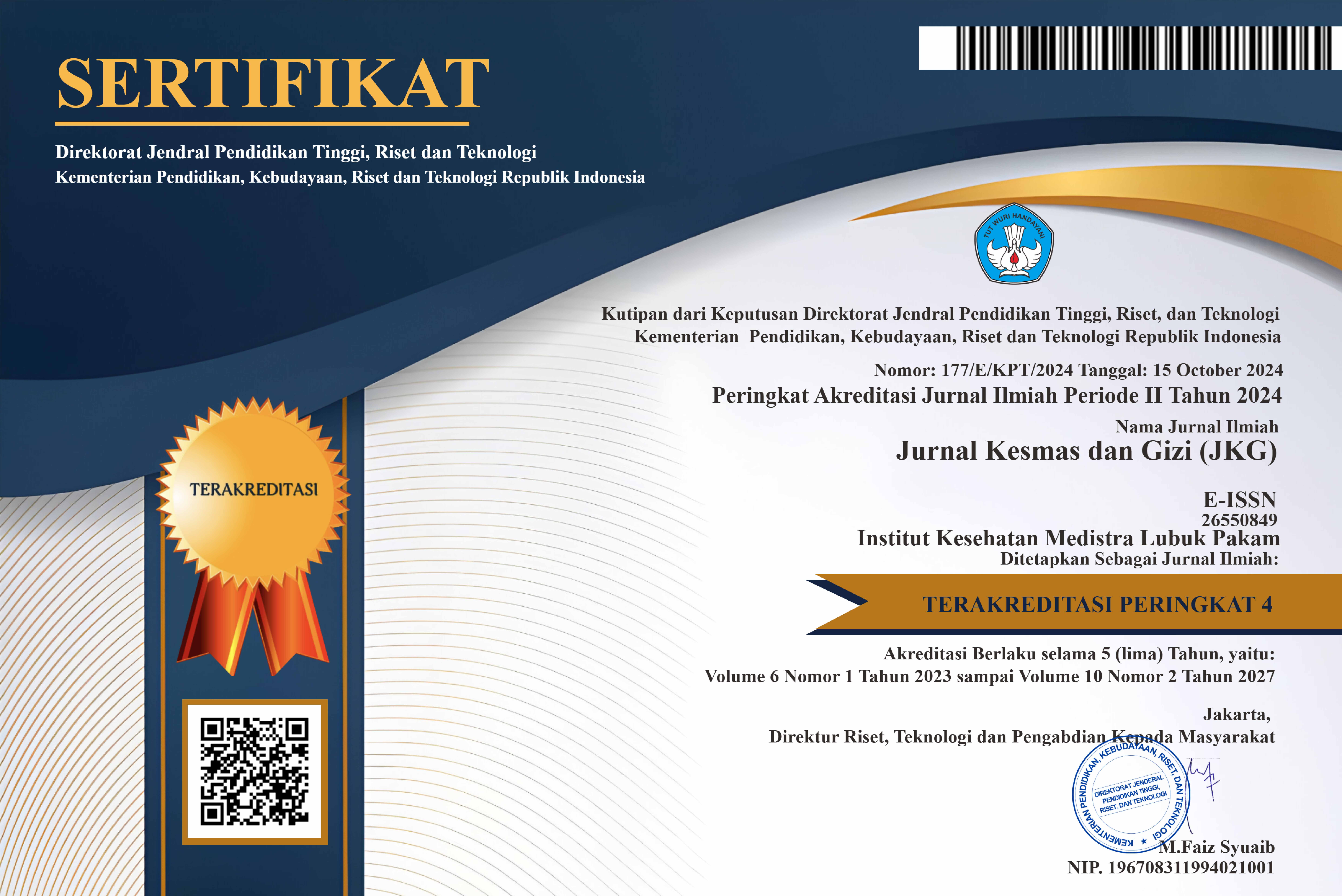Standardized Nutrition Care Process for Patients with Postoperative Cancer Pain Intra-Abdominal Tumors with Malnutrition : Case Study
DOI:
https://doi.org/10.35451/fzxyf910Keywords:
cancer pain, malnutrition, Proses Asuhan Gizi Terstandar, kanker kolorektalAbstract
Cancer is one of the leading causes of cancer deaths worldwide. Cancer patients often experience decreased food intake and poor nutritional status due to pain, nausea, vomiting, and the effects of chemotherapy and surgery. This case study aims to determine the implementation of the Standardized Nutrition Care Process (PAGT) in patients with post-operative cancer pain from an intra-abdominal tumor suspected of being a rectosigmoid mass, pre-chemotherapy, and malnutrition. The case study was conducted in May 2023 at Dr. Moewardi General Hospital in Surakarta. Data were obtained through interviews, observations, anthropometric measurements, biochemical examinations, and medical records. PAGT was carried out through the stages of assessment, diagnosis, intervention, monitoring, and nutritional evaluation. The patient was a 48-year-old woman who had experienced a 26% weight loss in the last 3 months with a BMI of 16.17 kg/m² and a waist circumference of 20.6 cm (malnutrition). Biochemical results showed anemia (Hb 11.5 g/dL). Energy and protein intake were far below requirements. Nutritional diagnoses established included: energy-protein malnutrition, inadequate oral intake, and risk of micronutrient deficiency. Interventions included a high-energy-protein diet and low residue diet with texture modifications and nutritional counseling. Monitoring showed improvement in intake, although it still did not meet requirements. The conclusion is PAGT in patients with intra-abdominal cancer and malnutrition can help identify nutritional problems and plan appropriate dietary interventions. Appropriate nutritional interventions are crucial to prevent worsening nutritional status and support the success of medical therapy.
Downloads
References
[1] Andinata B, Bachtiar A, Oktamianti P, Partahi JR, Dini MSA. A Comparison of Cancer Incidences Between Dharmais Cancer Hospital and GLOBOCAN 2020: A Descriptive Study of Top 10 Cancer Incidences. Indones J Cancer. 2023;17(2):119.
[2] Osborne A, Adnani QES, Ahinkorah BO. Breast cancer incidence in Indonesia: a sex-disaggregated analysis using WHO health equity assessment toolkit data. BMC Cancer. 2025;25(1).
[3] Factors R. Colorectal Cancer: Epidemiology, Risk Factors, and Prevention. 2024;
[4] Meng Y, Tan Z, Zhen J, Xiao D, Cai L, Dong W, et al. Global, regional, and national burden of early-onset colorectal cancer from 1990 to 2021: a systematic analysis based on the global burden of disease study 2021. BMC Med [Internet]. 2025;23(1). Available from: https://doi.org/10.1186/s12916-025-03867-9
[5] WHO (World Health Organization). Sustainable Development Goals Series. 2022. p. 1–21 Transforming our world: The 2030 Agenda for Sustainable Development Goals (SDGs). Available from: https://www.who.int/europe/home?v=welcome
[6] Shin AE, Giancotti FG, Rustgi AK. Metastatic colorectal cancer: mechanisms and emerging therapeutics. Trends Pharmacol Sci. 2023;44(4):222–36.
[7] Yamano T, Tomita N, Sato T, Hayakawa K, Kamikonya N, Matoba S, et al. Influence of chemoradiotherapy on nutritional status in locally advanced rectal cancer: Prospective multicenter study. Nutrition. 2020;77.
[8] Torkan P, Rahemi Z, Sadat Z, Ajorpaz NM. Effectiveness of a PRECEDE-PROCEED Model-based Educational Program on Health-Related Quality of Life and Preventive Behaviors in Patients with Breast Cancer Undergoing Chemotherapy. J Client-Centered Nurs Care. 2022;8(2):119–28.
[9] Kusuma F. The Role of Protein in Nutritional Support and Recovery of Ovarian Cancer Patients: A Narrative Review. J Kesmas Dan Gizi. 2025;7(2):297–303.
[10] Cederholm T, Jensen GL, Correia MITD, Gonzalez MC, Fukushima R, Higashiguchi T, et al. GLIM criteria for the diagnosis of malnutrition – A consensus report from the global clinical nutrition community. J Cachexia Sarcopenia Muscle. 2019;10(1):207–17.
[11] Kartika RJ, Mahmudiono T, Desi Natasya A. Pelaksanaan Asuhan Gizi Terstandar Pasien Kanker Serviks Iii B, Low Intake, Anemia. J Kesehat Tambusai. 2023;4(3):4198–205.
[12] Rahmadani QAN, Nurkusumahputri R, Muniroh L, Sumarmi S. Pemberian Diet Tinggi Energi Tinggi Protein Rendah Garam III dan Tinggi Antioksidan pada Pasien Kanker Payudara Stadium IIA: Sebuah Laporan Kasus. Media Gizi Kesmas. 2024;13(2):580–6.
[13] Nasir A, Bullo MMH, Ahmed Z, Imtiaz A, Yaqoob E, Jadoon M, et al. Nutrigenomics: Epigenetics and cancer prevention: A comprehensive review. Crit Rev Food Sci Nutr [Internet]. 2020;60(8):1375–87. Available from: https://doi.org/10.1080/10408398.2019.1571480
[14] PERSAGI & AsDi. Penuntun Diet dan Terapi Gizi. Jakarta: EGC; 2019.
[15] 1Mastuti Y, Akhriani M, Junita DE, Muharramah A. The Correlation Between Protein Intake And Muscle Mass in Breast Cancer Patients at Dr. H. Abdul Moeloek Regional Hospital. J Kesmas Dan Gizi. 2024;6(2):281–8.
[16] Jahrami H, Saif Z, Ammar A, Husain W, Trabelsi K, Ghazzawi H, et al. Development and Validation of a Food Frequency Questionnaire for Evaluating the Nutritional Status of Patients with Serious Mental Illnesses (DIETQ-SMI) in Bahrain. Brain Sci. 2024;14(4).
[17] Wilkinson N. Management of Rectal Cancer. Surg Clin North Am [Internet]. 2020;100(3):615–28. Available from: https://doi.org/10.1016/j.suc.2020.02.014
[18] Lusyana Nur L, Astuti NFW. Asuhan gizi pada pasien malignant neoplasma di RSD dr. Soebandi Jember. J SAGO Gizi dan Kesehat. 2023;4(2):265.
[19] Son J, Kang HI, Jung E young, Ryu H won, Lee KH. Effects of Continuous Nutrition Care on Nutritional Status and Dietary Habits of Patients With Colorectal Cancer Receiving Adjuvant Chemotherapy After Surgery. Clin Nutr Res. 2023;12(2):99.
[20] Pi J fang, Zhou J, Lu L ling, Li L, Mao C rong, Jiang L. A study on the effect of nutrition education based on the goal attainment theory on oral nutritional supplementation after colorectal cancer surgery. Support Care Cancer [Internet]. 2023;31(7):1–9. Available from: https://doi.org/10.1007/s00520-023-07905-1
[21] RIFQI NY. Pemberian Konseling Gizi Terhadap Tingkat Pengetahuan Diet Kanker, Tingkat Konsumsi (Energi, Protein, Vitamin C) Pada Pasien Kanker Payudara Dengan Kemoterapi Di Kota Malang. Nutr J. 2022;1(1):9.
[22] Andjarwati R, Gayatri D, Afiyanti Y. EFEKTIVITAS INTERVENSI EDUKASI NUTRISI PADA OSTOMATE PASKA OPERASI DIGESTIF. 2022;4(1):1–23.
[23] Li J Bin, Luo S, Wong MCS, Li C, Feng LF, Peng JH, et al. Longitudinal associations between BMI change and the risks of colorectal cancer incidence, cancer-relate and all-cause mortality among 81,388 older adults. BMC Cancer. 2019;19(1):1–13.
[24] Arends J. Malnutrition in cancer patients: Causes, consequences and treatment options. Eur J Surg Oncol [Internet]. 2024;50(5):107074. Available from: https://doi.org/10.1016/j.ejso.2023.107074
[25] WHO (World Health Organization). 2020. Key Facts of cancer.
[26] Chardalias L, Papaconstantinou I, Gklavas A, Politou M, Theodosopoulos T. Iron Deficiency Anemia in Colorectal Cancer Patients: Is Preoperative Intravenous Iron Infusion Indicated? A Narrative Review of the Literature. Cancer Diagnosis Progn. 2023;3(2):163–8.
[27] Fritche D, Wensley F, Johnson YL, Robins C, Wakatsuki M, Fecher-Jones IC, et al. Intravenous Iron for Perioperative Anaemia in Colorectal Cancer Surgery: A Nested Cohort Analysis. Cancers (Basel). 2025;17(11):1–11.
[28] Beaudry AG, Law ML. Leucine Supplementation in Cancer Cachexia: Mechanisms and a Review of the Pre-Clinical Literature. Nutrients. 2022;14(14):1–15.
[29] Petrova B, Kanarek N. Potential benefits and pitfalls of histidine supplementation for cancer therapy enhancement. J Nutr [Internet]. 2020;150:2580S-2587S. Available from: https://doi.org/10.1093/jn/nxaa132.
Downloads
Published
Issue
Section
License
Copyright (c) 2025 Siti Aisyah, Winda Rizki Pebrina Batubara

This work is licensed under a Creative Commons Attribution 4.0 International License.
Copyright in each article is the property of the Author.


























